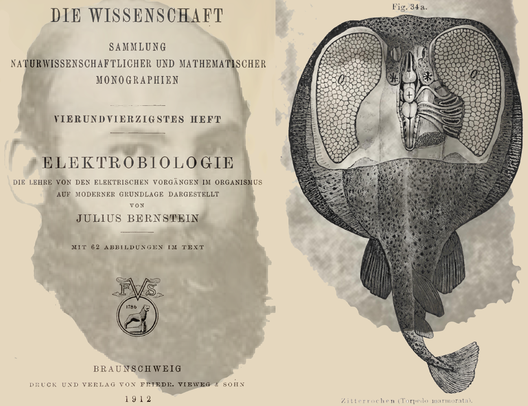Julius Bernstein1839–1917
Bernstein worked with du Bois-Reymond and Rudolf Heidenhain (1834-1879) in Berlin and with Helmholtz in Heidelberg before his post as professor of physiology at the University of Halle. Bernstein was a prominent member of the so-called school of the “organic physicists”, who endeavoured to explain live processes on the basis of purely physico-chemical principles. This was in contrast to the vitalistic conceptions of the exponents of Naturphilosophie that was dominating German science. Bernstein stands out as the major contributor to the physiology and biophysics of nerve and muscle excitability of his era, bringing to completion the work of his teachers with his “membrane theory” developed initially on thermodynamic principles in 1902 and expounded in its mature form in 1912 with the publication of the landmark work Elektrobiologie. This theory, based on the electrochemical principles elaborated by Walter Nernst (1864-1941) and on the advancements in the study of biological and artificial membranes of his era, put the movement of ions, and particularly K+ at the heart of the electric excitability of muscle and nerve fibres. It substituted the “electric molecules” hypothesis of du Bois-Reymond and was to remain the reference theory until the landmark studies of Hodgkin and Huxley in the mid of the twentieth century. Among Bernstein’s momentous experimental successes is the recording in 1868 of the waveform of the elementary electric signal in nerve. This was obtained with an especially contrived instrument, the “differential rheotome”, capable of recording, by using a slow-response galvanometer (of the time constant of the order of seconds) an event of about one millisecond-duration. As with other physiologists and physicists of his time, Bernstein was deeply interested in electric fish and, at the beginning of the twentieth century, he investigated experimentally, with his collaborator Armin Tschermak (1870-1952), the thermodynamics of torpedo’s discharge in order to provide support for his membrane theory. His more important achievement in the field is, however, the elaboration of the correct theory of the fish shock expounded in 1912 in his Elektrobiologie. He addressed the issue of why the assembly of excitable cells in the special organs of the fish can produce a high voltage potential, whereas only weak electric signals are produced by the ensemble of excitable cells in ordinary animal. To account for this Bernstein invoked a fundamental asymmetry of the two leaflets of the membrane of the flat-shaped cells of the electric organs (electrocytes). According to him, only one of the leaflets is excitable (in the torpedo the lower one), while the other only transmits the ionic current generated by the excitable element. In this way the symmetry problem hindering the external summation of the potentials generated by the ensemble of electrocytes is counteracted. Bernstein is shown on the left in combination with the title page of his Elektrobiologie which was published in 1912, and he is shown on the right in his illustration of the torpedo taken from his book.
